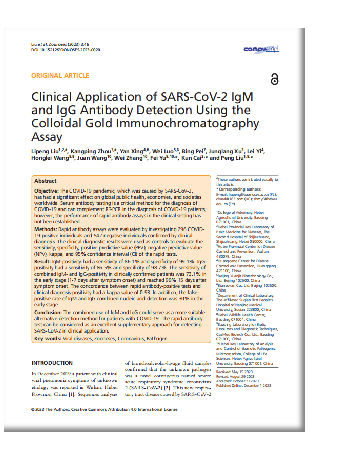科技成果
科學承載生命 國蘭創(chuàng)造奇跡科技成果


Lipeng Liu, Kangping Zhou, Yan Xing, Wei Luo, Bing Pei, Junqiang Xu, Lei Yi, Honglei Wang, Juan Wang, Wei Zhang, Fei Yu,Kun Cai,and Peng Liu
College of Veterinary, Hebei Agricultural University, Baoding 071001, China
Hebei Provincial Key Laboratory of Basic Medicine for Diabetes, The Second Hospital of Shijiazhuang, Shijiazhuang, Hebei 050000, China
Hubei Provincial Center for Disease Control and Prevention, Wuhan 430079, China
Huanggang Center for Disease Control and Prevention, Huanggang 421100, China
Beijing Yuanjit Biotechnology Co., Ltd. Beijing 102600, China
Bioneovan Co., Ltd. Beijing 102600, China
Department of Clinical Laboratory, The Affiliated Suqian First People’s Hospital of Nanjing Medical University, Suqian 223800, China
Hebei Wildlife Health Center, Baoding 071001, China
Baoding Laboratory for Biotic Resources and Diagnostic Techniques, CasMed Biotech Co., Ltd., Baoding 071000, China
Hebei Key Laboratory of Analysis and Control of Zoonotic Pathogenic Microorganism, College of Life Sciences, Hebei Agricultural University, Baoding 071001, China
Abstract:Objective: The COVID-19 pandemic, which was caused by SARS-CoV-2, has had a significant effect on global public health, economies, and societies worldwide. Serum antibody testing is a critical method for the diagnosis of COVID-19 and can complement RT-PCR in the diagnosis of COVID-19 patients; however, the performance of rapid antibody assays in the clinical setting has not been established.
Methods: Rapid antibody assays were evaluated by investigating 296 COVID-19-positive individuals and 542 negative individuals confirmed by clinical diagnosis. The clinical diagnostic results were used as controls to evaluate the sensitivity, specificity, positive predictive value (PPV), negative predictive value (NPV), kappa, and 95% confidence interval (CI) of the rapid tests.Result: IgM-positivity had a sensitivity of 86.1% and specificity of 99.1%. IgG_x0002_positivity had a sensitivity of 86.5% and specificity of 98.7%. The sensitivity of combined IgM- and IgG-positivity in clinically confirmed patients was 73.1% in the early stage (1-7 days after symptom onset) and reached 99% 15 days after symptom onset. The concordance between rapid antibody-positive tests and clinical diagnosis-positivity had a kappa value of 0.93. In addition, the false_x0002_positive rate of IgM and IgG combined nucleic acid detection was 30% in the early stage.
Conclusion: The combined use of IgM and IgG could serve as a more suitable alternative detection method for patients with COVID-19. The rapid antibody test can be considered as an excellent supplementary approach for detecting SARS-CoV-2 in clinical application.